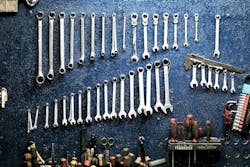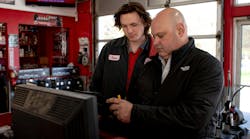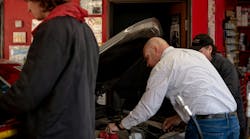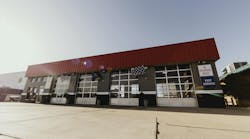Many of us live and die by our ability to keep a spreadsheet organized and color-coded. If you’re a business owner, chances are, you are one of us.
Every year, the climate in the quick lube industry gets hotter. Increasing competition means your customers have more options than ever before when it comes to maintaining their vehicles. You’re well aware — you can’t just check fluids, change an air filter and send the customer on their way the way some shops used to. You must stand out amongst the competition. Staying profitable is a game, and while your employees might tell you the trick is to make your quick lube a “Pokestop” (not a terrible idea by the way), we think there are a few other tried-and-true ways to stay on the uptick of profitability and win the game of quick lube competition year over year.
The National Oil & Lube News Fast Lube Operator and Oil Change-Plus surveys are great ways to get a pulse on the industry every 12 months or so. Every year, NOLN counts on you to send in the cold, hard facts from the field. NOLN compiles all of your data and puts it up against historical metrics from years past. We study, analyze and compare in hopes you will do the same. After 30 years, we’re convinced it’s one of the secrets to winning the fast lube game and continually growing your business.
This year is no different. We’ve compared, contrasted, analyzed and discussed the metrics we think are most intriguing from this year’s survey. We’ve grouped them into three basic categories to consider — cost, efficiency and customer habits. Hopefully our analysis will help you think of at least one way you can better your business.
First up is cost. This year, the average cost of goods increased by $2.43, rising from $12.91 in 2015 to $15.34 in 2016. When you’re planning your method of attack to win 2017, keep the rising cost of goods in mind and consider some ways you will combat that number. There could be several reasons why your cost of goods is rising. Sure, some of it is probably out of your control — things cost what they cost — but try to focus on the aspects you can control like inventory, having less waste and strategically walking the fine line of raising prices while staying competitive.
According to the 2016 survey, many operators have already adjusted their sails when it comes to their prices. The average price of a regular oil change rose from $38.58 in 2015 to $41.18 in 2016. That wasn’t the case, however, for the average price of synthetic oil changes. In 2015, the average price of a synthetic oil change was $79.54, while this year operators reported the average price was $75.45. That’s a savings of $4.09 and one-heck of a strategic plan. Think about it, while most operators raised the price of a regular oil change, they reduced the cost of their premium service, thus staying profitable, competitive and fair in the eyes of the customers rolling into their bays. The numbers don’t lie. In 2016, average ticket prices were up $2.35 from $69.01 in 2015 to $71.36 in 2016. So, while operators experienced a higher cost of goods, they were able to lower their average price of synthetic oil changes, stay competitive and profitable.
Next, let’s talk about efficiencies. This is something your shop is probably really good at or struggles with. It’s hard to ride the wave when it comes to being efficient and chances are, you either do it really well or you find yourself wondering where the day went and why you were constantly derailed all day long. Chances are, if you lead efficiently, it will trickle down to your staff, and that’s a good thing for everyone involved. In 2016, you told us things got a lot faster in your bays. The average bay time in 2016 was 12.8 minutes, while in 2015 it was 18.4 minutes. Now, that’s how to literally increase your profitability in a matter of minutes. Be good but not at the sake of being fast. Be fast but not to the detriment of being excellent.
Now that we’ve talked about your habits, let’s talk about your customers’ habits — and no, I’m not talking about the fact that a few of them never say, “Thank you” and always treat your staff like they are trying to pull one over on them. In 2016, the amount of 0W-20 motor oil that was used grew 3 percent, from 11 percent in 2015 to 14 percent. This is, of course, due to more cars requiring 0W-20 being on the roadways but it also reflects on the buying habits of your customers. They’re buying new cars that get better mpg. If you’re a shop owner, you know more than anyone how important it is for your staff to stay on the cutting-edge of technology and education. The automotive industry is constantly changing and developing, and your team must stay on top of it all to be able to service any car that may roll up to your bays. Education is definitely a key to winning against your competition.
In 2016, the survey reported you were getting your customers back in your bays after an average of 4,532 miles. In 2015, that number was 4,858 miles. Maybe that means you’ve trained your customers well or maybe it means they’re sick of hearing you tell them they waited too long between oil changes. Either way, keep it up! If you cut the miles between oil changes by another 326 miles in 2017 chances are you’ll probably be finishing first, too.
These are just a few of the highlights and comparisons from the 2016 Fast Lube Operator Survey that are good to check out if you’re interested in how you can have a better 2017. I encourage you to take a look for yourself and compare your personal knowledge of your business with the industry standards to see where you can improve and where you’re beating the average. Be hungry enough to keep pushing, learning and growing, even if you’ve been in the industry for 30 years and counting. It’s easy to get comfortable and go through the motions, but this year, challenge yourself to do the opposite by reading, studying and crushing your opponents in this game of friendly (or not so friendly) quick lube competition. We can’t wait to report on it next year.





